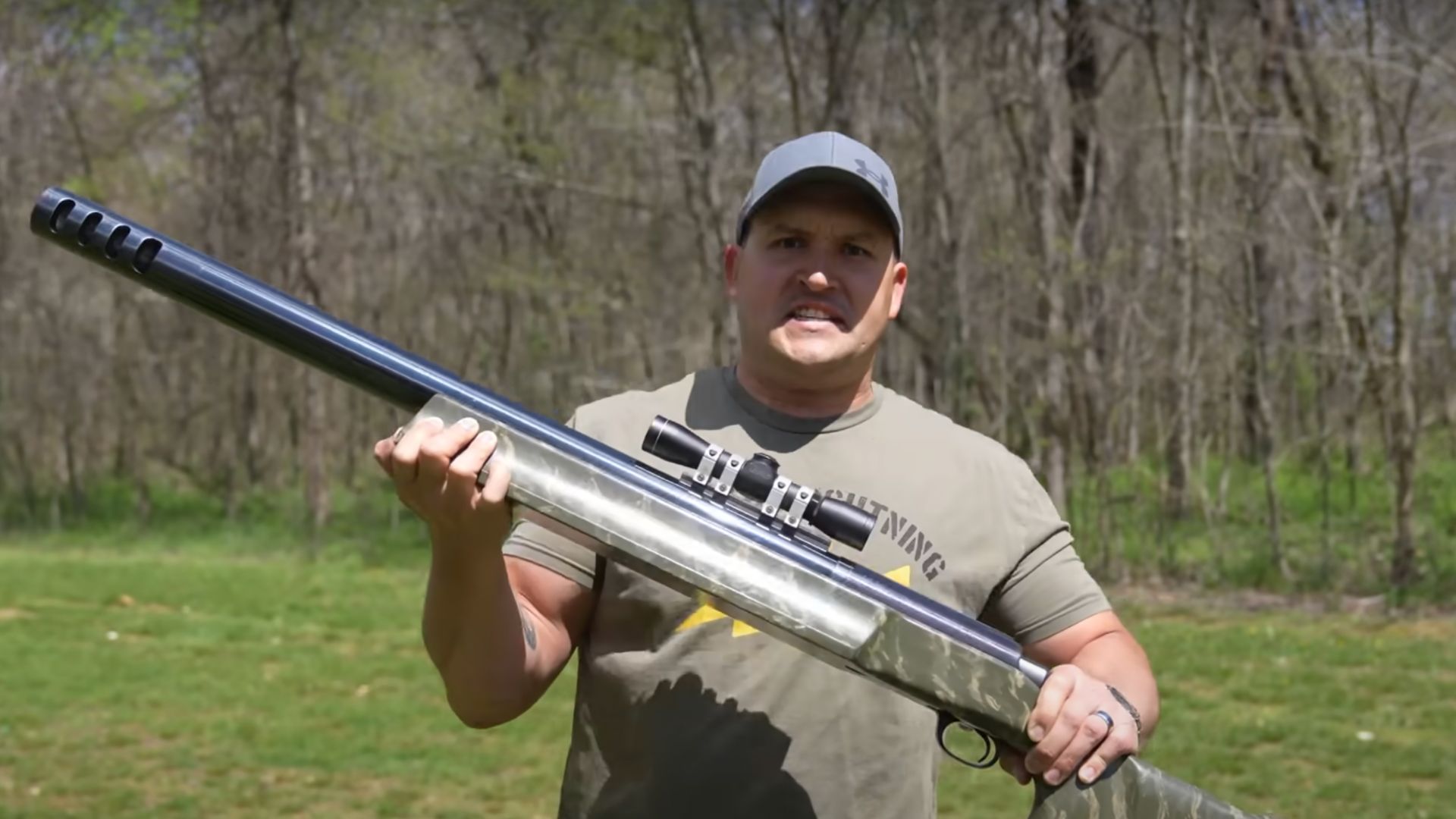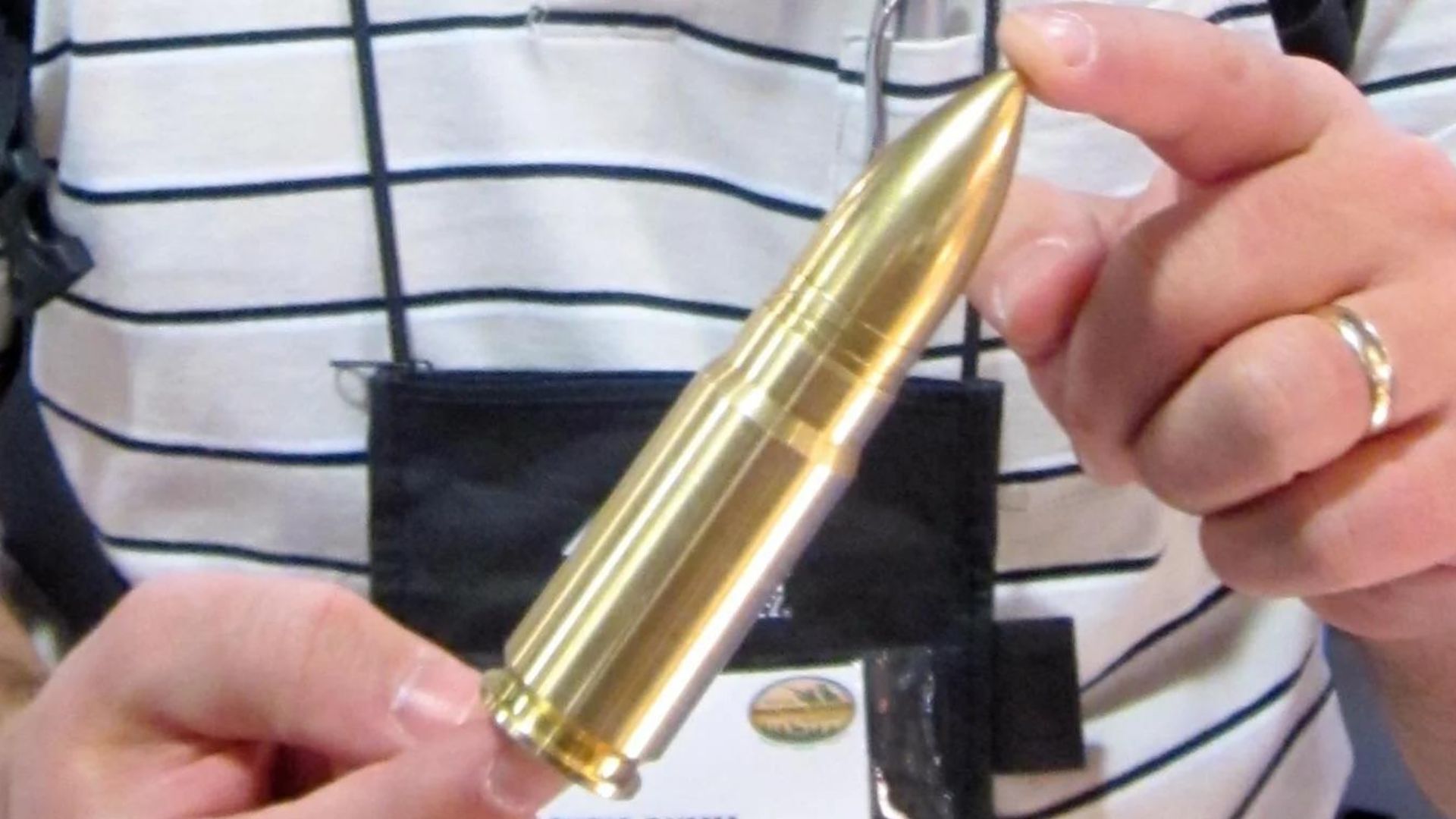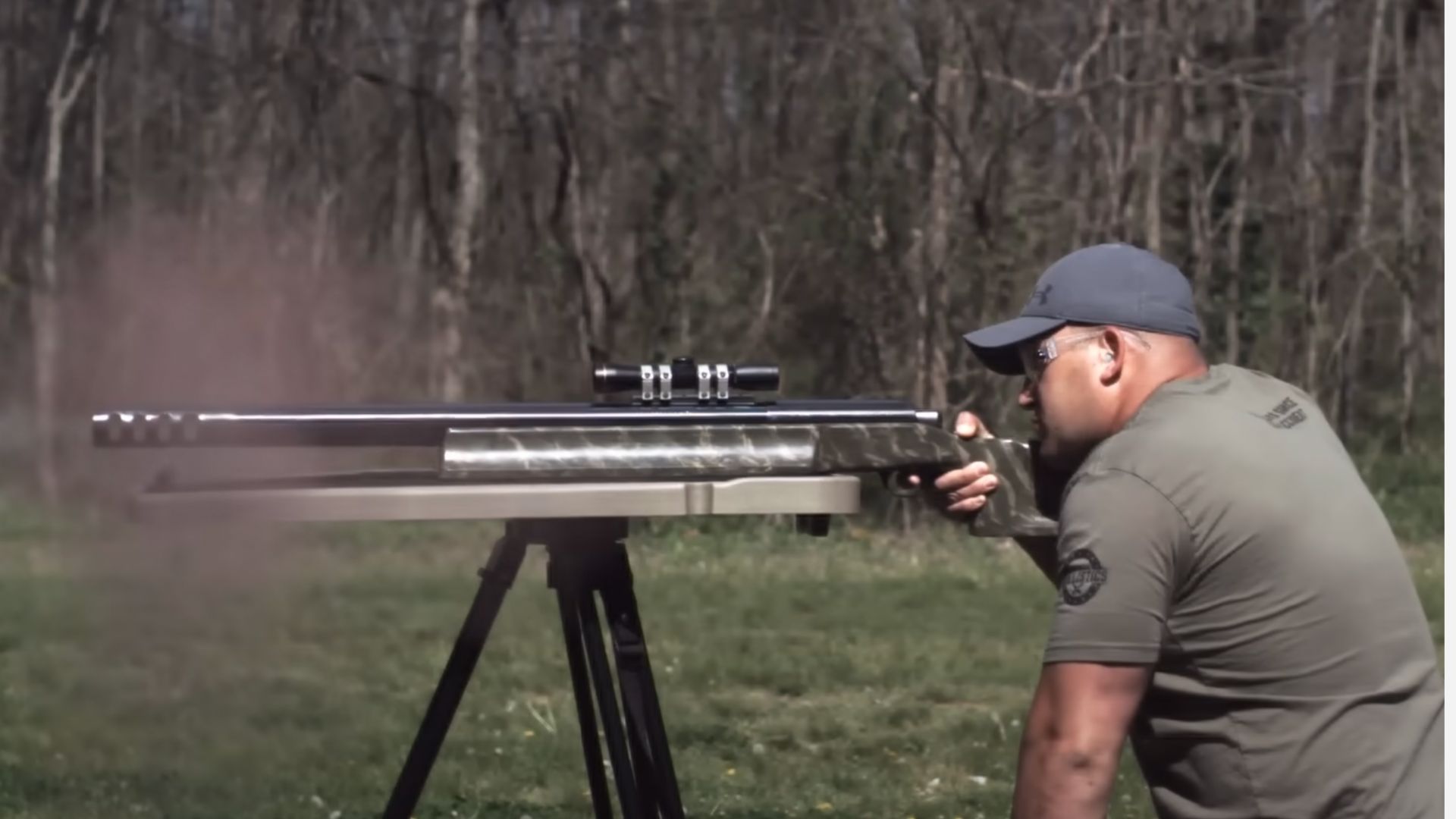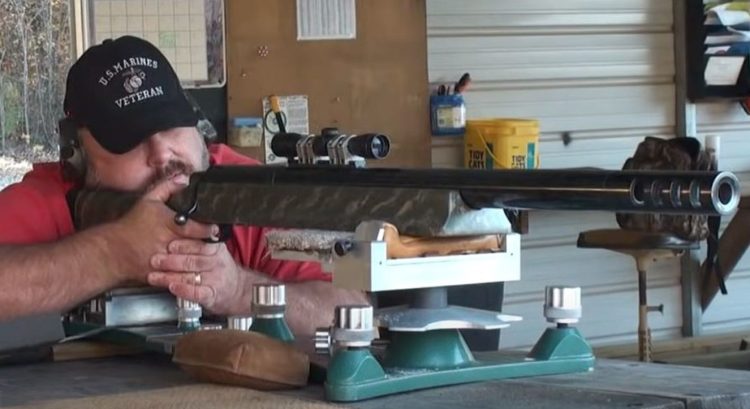Meet the “Fat Mac.” If bigger and more powerful are better, it doesn’t get much better than Fat Mac.
The .950 JDJ rifle, developed by J.D. Jones of SSK Industries is a remarkable achievement in firearms engineering. Known for its extraordinary size and power, it has captured the interest of shooting enthusiasts and collectors alike.
Chambered for a custom .950-inch cartridge, the .950 JDJ is one of the largest and most powerful rifles ever created. While it may not have practical applications in the field, its engineering and ballistic capabilities make it a unique and fascinating weapon, earning it a reputation as a “range queen” that commands attention wherever it’s fired.
The Cartridge and Design
At the core of the .950 JDJ is its cartridge, which is nothing short of extraordinary. The cartridge is based on a modified 20×110mm Vulcan Cannon cartridge, typically used in anti-aircraft ammunition. If you’ve never heard a Vulcan fire, it’s like a Mingun on steroids. I love the sound and check out that belt of ammo being fired. Imagine shooting one of those rounds through a rifle, and you’ve got the Fat Mac experience.

Jones shortened this case and necked it up to accommodate a .950-inch bullet, creating one of the largest rifle calibers ever developed. Even experienced shooters find the sheer size of the bullet and the cartridge impressive.
The bullets used in the .950 JDJ are custom-made and typically weigh around 3,600 grains (approximately 230 grams). To put this into perspective, a standard .50 BMG bullet weighs around 700 grains. Remember, there are 7000 grains to a pound.
The .950 JDJ bullet is more than five times heavier, making it a formidable projectile. The loaded cartridges measure nearly the length of an empty .50 BMG casing, standing around four inches tall. Such firepower is uncommon in conventional rifles, placing the .950 JDJ in a class of its own.
The bore diameter of the .950 JDJ rifle is indeed 0.950 inches, which is extremely large for a shoulder-fired firearm. Normally, firearms with a bore diameter exceeding 0.50 inches are classified as Destructive Devices under the 1968 National Firearms Act. This is truly the “monster truck” of rifles, weighing in at a scale-smashing 85 lbs. It’s not exactly something our soldiers are going to be lugging through the bush unless they are hunting for dinosaurs.
However, SSK Industries obtained a “Sporting Purposes Exception” for this rifle, allowing it to be sold as a Title I firearm. This means that individuals over the age of 18 with a clean criminal record can legally purchase the rifle without the additional regulatory hurdles typically associated with Destructive Devices.
Engineering Feat
Rifles chambered for the .950 JDJ are feats of engineering designed to handle the extreme pressures and forces generated by such a large cartridge. These rifles are built with durable McMillan stocks and heavy-duty Krieger barrels. The barrels are designed to withstand the intense pressures generated by firing a .950-inch bullet.

One of the most critical components of the .950 JDJ rifle is its muzzle brake, which weighs in at a hefty 18 pounds. The rifle’s recoil is significant (understatement) given the power of the cartridge, so the muzzle brake effectively manages it. Without the muzzle brake, firing the rifle would generate a recoil force that could potentially injure the shooter or damage the rifle.
Depending on the configuration, these rifles weigh between 85 and 110 pounds. This weight is necessary to absorb the recoil and ensure the rifle’s structural integrity.
However, it also makes the rifle impractical for anything other than bench-rest shooting. The rifle’s weight and size mean that it’s not something you would carry into the field for hunting or tactical operations. Instead, it’s intended for shooting ranges, where shooters can safely and effectively demonstrate its power.
Despite its weight, the recoil generated by the .950 JDJ is substantial. The force generated when firing the rifle is so great that it requires specialized components, such as reinforced scopes and bipods, capable of withstanding the immense stress. Standard scopes and bipods would likely fail under the strain of firing the .950 JDJ, making these reinforced components a necessity.
Practicality and Use
It’s important to understand that the .950 JDJ rifle wasn’t designed with practicality in mind. Its massive size, weight, and power make it unsuitable for most conventional shooting activities. It is the concept of ‘Murica personified.

You won’t find hunters or soldiers carrying this rifle in the field. Instead, it’s often referred to as a “range queen,” a term used to describe firearms brought to shooting ranges primarily for the experience and spectacle of firing them.
The cost of owning and operating a .950 JDJ rifle is prohibitive for most shooters, with rifles priced around $8,000 or more. Additionally, the cost of ammunition is equally steep, with loaded cartridges costing around $40 each.
The rounds, custom-made and lathe-turned from bronze, are priced at $10 apiece. These costs make the .950 JDJ a luxury item, accessible only to those who can afford the significant expense associated with owning and shooting one.
Ballistic Power
When it comes to ballistics, the .950 JDJ is a powerhouse. The rifle propels its 3,600-grain bullet at approximately 2,200 feet per second, generating a muzzle energy of 38,685 foot-pounds.

This level of kinetic energy is comparable to the original tank rounds used during World War I.
The sheer power of the .950 JDJ allows it to penetrate multiple layers of body armor. Let’s imagine for a second that a bad guy were to be shot with one of these. He would likely be turned into a cloud of pink mist that would disperse itself over three counties, never to be seen again.
The recoil generated by the .950 JDJ is also substantial. In a 110-pound rifle, the recoil energy exceeds 200 foot-pounds, far beyond the shoulder-firing capacity of most individuals.
For comparison, a typical .30-06 hunting rifle generates around 20 foot-pounds of recoil energy. The recoil of the .950 JDJ is more than ten times greater, typically requiring a heavy “lead sled” or a similar shooting rest for safe firing. These devices help mitigate the extreme recoil, preventing injury to the shooter from being knocked on his ass and ensuring the rifle’s structural integrity remains intact.
The .950 JDJ: A Rifle Too Powerful for Military Use?
When considering the practicality of the .950 JDJ as a military weapon, it’s clear that “sometimes, too much is just too much.” The rifle’s immense size, weight, and recoil make it a poor choice for any standard military application.
In a combat scenario, soldiers require weapons that are versatile, portable, and effective across various situations. The .950 JDJ, however, is an extreme example of firepower that exceeds what is necessary or practical on the battlefield. In reality, it’s what we call a “show pony.”
Comparing to the Largest Rifle in U.S. Military Use
The U.S. military currently uses the .50 BMG (Browning Machine Gun) round in rifles like the Barrett M82, which is designed for long-range anti-material and sniper roles.
The .50 cal weapon fires a 700-grain bullet at approximately 2,800 feet per second, generating a muzzle energy of around 12,000 foot-pounds. In comparison, the .950 JDJ’s 3,600-grain bullet with its 38,685 foot-pounds of muzzle energy dwarfs the .50 BMG in sheer power, but this comes with significant drawbacks.
Overkill: The Unnecessary Power of the .950 JDJ
One must ask: who is this weapon made for? Is it the Desert Eagle of rifles, designed more for show than for practical use?
The .950 JDJ might be seen as a symbol of America’s fascination with bigger, more powerful weaponry, but in reality, it represents a level of overkill that is impractical for most applications. The excessive power and recoil make it unsuitable for precision shooting, and its massive size renders it impossible to deploy in the field effectively.
The Most Comparable Historical Military Weapon
The most closely comparable military weapon to the .950 JDJ in terms of size and power might be the Soviet PTRS-41 anti-tank rifle, which was used during World War II.
The PTRS-41 fired a 14.5×114mm round designed to penetrate armored vehicles. However, even this rifle was considered cumbersome and was eventually phased out in favor of more effective anti-tank weaponry. The .950 JDJ, while even more powerful, shares similar limitations and is ultimately impractical for modern military use.
The Cultural Symbolism of the .950 JDJ
In many ways, the .950 JDJ can be seen as a symbol of excess — both in terms of its physical attributes and what it represents in firearms culture.
It’s a rifle that exists more as a testament to what can be done in firearms engineering rather than what should be done. It’s the kind of weapon that appeals to those with the means to indulge in the extremes, perhaps overcompensating for something else (insert eggplant emoji here).
In essence, it’s a reminder that just because you can build something doesn’t mean it has practical value, especially in the context of military applications.
Cultural Impact and Significance
The .950 JDJ rifle has garnered a cult following among firearms enthusiasts and collectors. I’d love to fire one just one time to see how badly I could knock my shoulder out of whack.

Serious Firepower
The .950 JDJ rifle stands as a unique and powerful piece of firearms history. This guy below says so.
Its engineering, ballistic power, and cultural impact make it a noteworthy addition to any firearms collection.
Those who have the opportunity to fire the .950 JDJ are often left in awe of its capabilities. It’s a rifle that commands respect, both for its power and the engineering expertise required to create it. While it may not be a practical tool for most shooters. It remains a symbol of extreme ballistics and a fascinating example of what can be achieved in the world of firearms engineering.
__
Disclaimer: SOFREP utilizes AI for image generation and article research. Occasionally, it’s like handing a chimpanzee the keys to your liquor cabinet. It’s not always perfect and if a mistake is made, we own up to it full stop. In a world where information comes at us in tidal waves, it is an important tool that helps us sift through the brass for live rounds.









